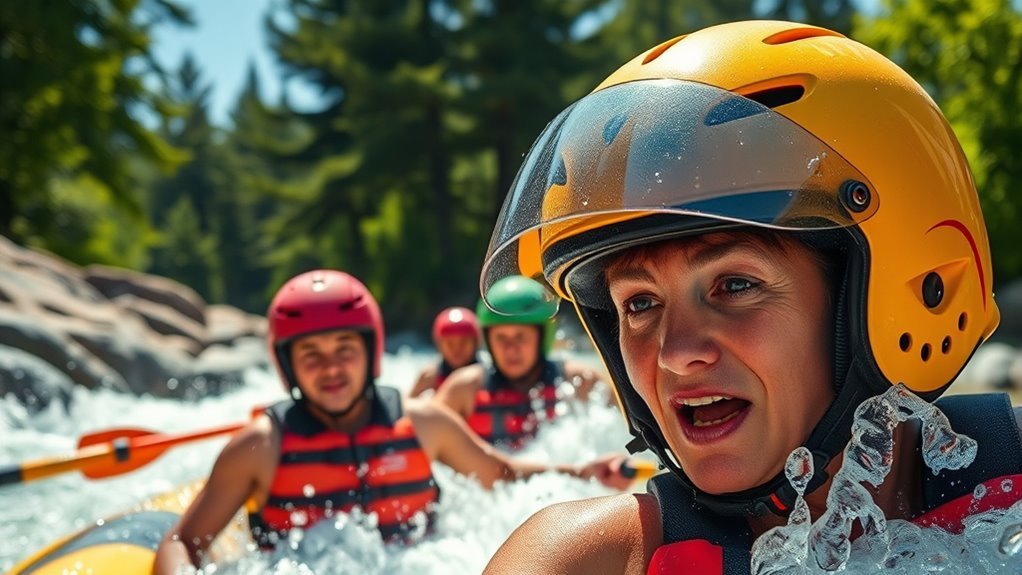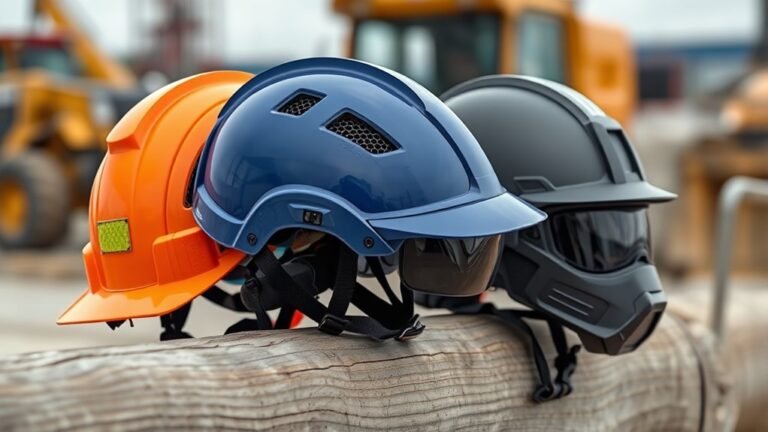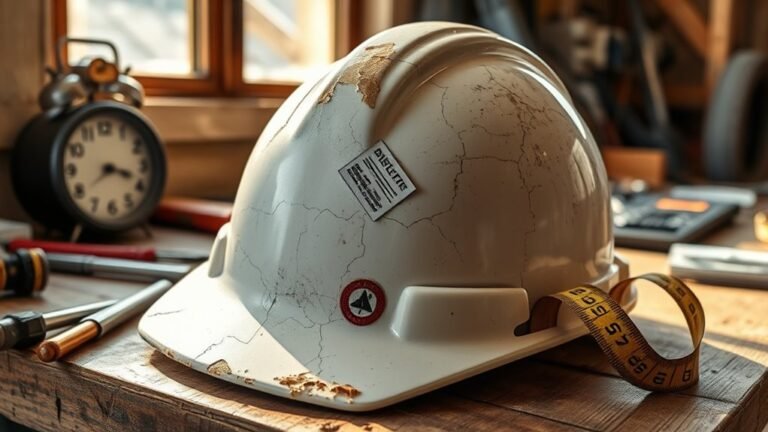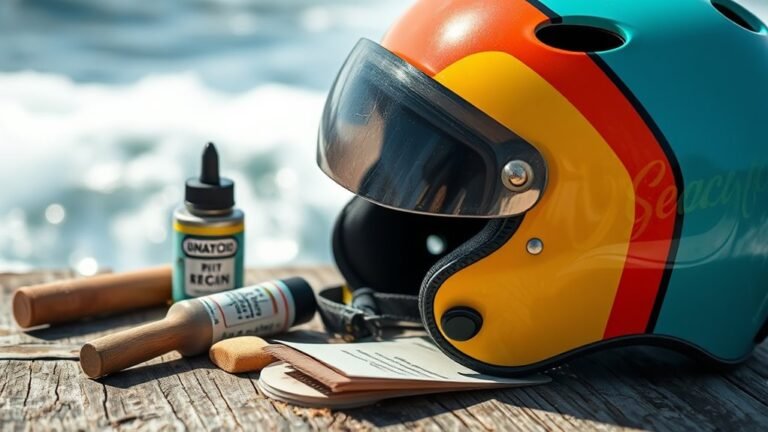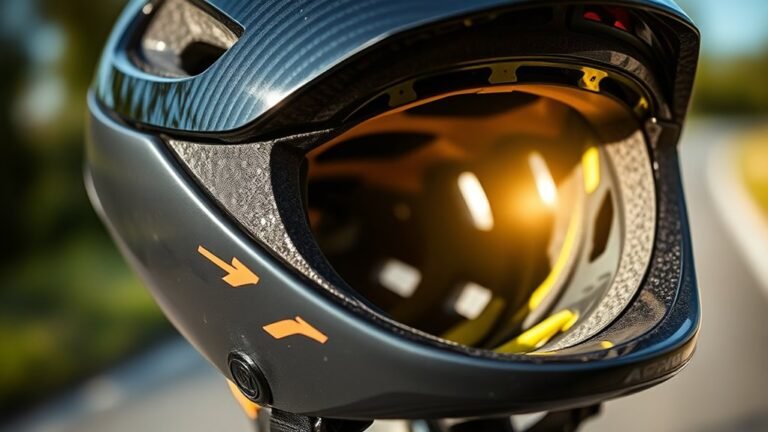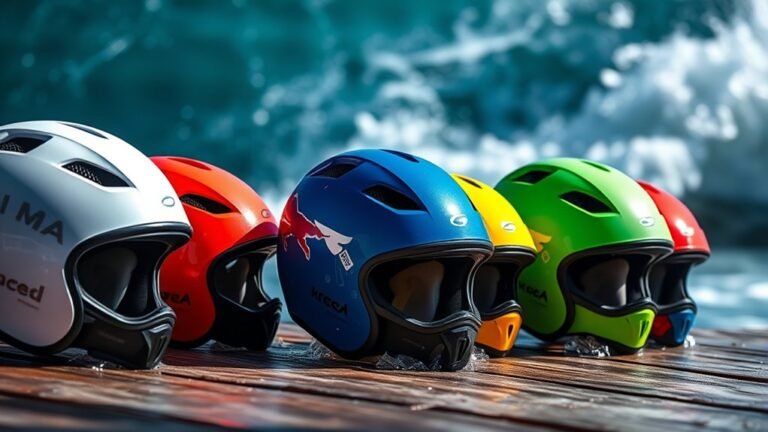Safety Tips for Using Helmets in Whitewater Rafting
Wearing a helmet in whitewater rafting is essential for your safety. Choose a durable helmet with good ventilation and a secure fit. Always inspect it for cracks or wear before use. Make sure it meets safety standards and is appropriate for your activity. Rinse it after each use, clean it with mild soap, and store it properly to extend its life. If you’re curious about more safety gear and tips, there’s plenty more to explore.
Choosing the Right Helmet for Whitewater Rafting

When it comes to whitewater rafting, your helmet is your first line of defense against potential head injuries. Choosing the right helmet involves understanding key helmet features and materials that guarantee safety and comfort. Look for a helmet made from durable materials like polycarbonate or fiberglass, which provide excellent impact resistance while remaining lightweight. Ventilation holes are essential, too, as they keep you cool during intense paddling. Additionally, consider helmets with adjustable straps for a secure fit, preventing any unwanted movement during your adventure. A visor can shield your eyes from sun and water spray, enhancing your experience. Prioritize safety without sacrificing freedom—select a helmet that combines robust protection with comfort to fully enjoy the thrill of whitewater rafting.
Ensuring a Proper Fit
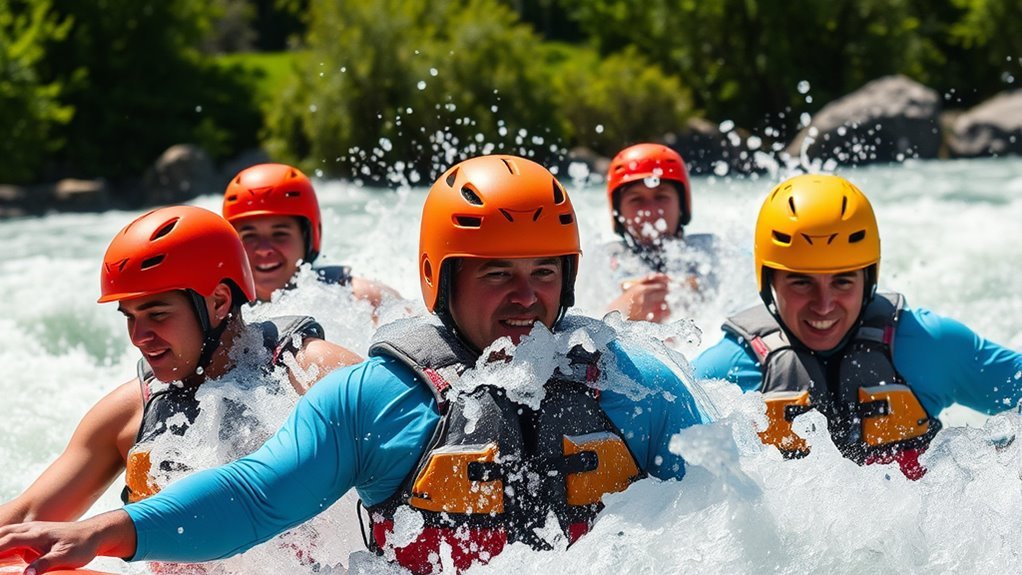
A helmet can only protect you if it fits properly. To guarantee safety in whitewater rafting, start by selecting the right helmet sizing for your head. Measure your head circumference, and refer to the manufacturer’s sizing chart. Once you’ve got the right size, make fit adjustments. Most helmets come with adjustable straps and padding; use them to create a snug fit without being overly tight. The helmet should sit level on your head, covering your forehead without obstructing your vision. You shouldn’t feel any shifting while paddling. Remember, a secure helmet allows you to feel free and confident on the water, knowing you’re protected from potential impacts. Prioritize fit for the ultimate rafting experience!
Inspecting Your Helmet Before Use

Before hitting the rapids, it’s essential to inspect your helmet. A thorough helmet inspection can prevent accidents and guarantee your safety. Use these helmet inspection techniques to identify any common helmet damages:
- Check for Cracks: Look for visible cracks or chips that could compromise the helmet’s integrity.
- Inspect the Straps: Verify the chin straps and buckles are intact and securely fastened.
- Look for Deformation: Make sure the helmet hasn’t lost its shape or showed signs of denting.
- Examine Padding: Confirm that the inner padding is in good condition and hasn’t worn down.
Taking these steps before your adventure will keep you protected and let you enjoy the thrill of whitewater rafting with peace of mind.
Understanding Helmet Ratings and Standards
Understanding helmet ratings and standards is essential for safeguarding your safety while whitewater rafting. Helmets are tested for impact resistance, which determines how well they can protect you during a fall or collision. Look for helmets that meet recognized safety certifications, like ASTM or CE standards, as these indicate reliable performance.
Consider the helmet materials used; high-quality polycarbonate or fiberglass shells provide durability and better impact resistance. A lightweight design can enhance comfort without sacrificing safety, allowing you to focus on the thrill of your adventure. Always check the manufacturer’s specifications to verify your helmet fits the intended use. By choosing a helmet with the right ratings, you’re not just protecting yourself, but also embracing the freedom and excitement of whitewater rafting.
Tips for Helmet Maintenance and Care
Maintaining your helmet is essential for guaranteeing its longevity and effectiveness while whitewater rafting. Proper care can make a big difference in your safety. Here are some tips for helmet maintenance:
- Helmet Cleaning: After each use, rinse your helmet with fresh water to remove dirt and debris. Use mild soap for deeper cleaning, but avoid harsh chemicals.
- Drying: Always air-dry your helmet completely before storing it; never use direct heat sources.
- Storage Techniques: Keep your helmet in a cool, dry place away from direct sunlight to prevent material degradation.
- Inspection: Regularly check for cracks or dents. If you notice any damage, it’s time to contemplate replacement.
Following these steps guarantees your helmet stays in top shape for those thrilling rafting adventures.
When to Replace Your Helmet
Even with proper maintenance, helmets have a limited lifespan and need to be replaced periodically to guarantee your safety on the water. Typically, a helmet lasts about three to five years, but it’s crucial to assess its condition regularly. Look for signs of damage, such as cracks, dents, or worn-out padding. If you notice any of these issues, it’s time to invest in a new helmet. Additionally, exposure to harsh elements like UV rays can weaken the material over time, even if the helmet appears intact. Don’t compromise your safety for the sake of saving a few bucks; replacing your helmet when needed guarantees you stay protected while enjoying the thrilling freedom of whitewater rafting.
Additional Safety Gear to Consider
In addition to your helmet, it’s essential to think about other safety gear for whitewater rafting. Personal flotation devices, protective clothing, and proper footwear can greatly enhance your safety on the water. Each piece of gear plays an important role in keeping you secure during your adventure.
Personal Flotation Devices
When you’re preparing for a whitewater rafting adventure, having a reliable personal flotation device (PFD) is essential for safety. Choosing the right PFD can make all the difference in your experience. Here are some personal flotation device types to evaluate:
- Type III PFD: Ideal for recreational activities, offering good mobility and comfort.
- Type V PFD: Designed for specific uses like kayaking or jet skiing, often with added features.
- Inflatable PFD: Lightweight and compact, they inflate automatically in water but require maintenance.
- Standard Vest PFD: Provides basic buoyancy and is often the most affordable option.
Make sure your PFD fits snugly and meets safety regulations. With the right personal flotation device, you can enjoy the thrill of the rapids while staying safe.
Protective Clothing Options
Choosing the right protective clothing can enhance your whitewater rafting experience and keep you safe on the water. Opt for gear that includes protective layers designed for impact resistance, shielding you from rocks and debris. Look for a durable, quick-drying fabric that offers flexibility and comfort, allowing you to move freely while paddling. A wetsuit or drysuit can provide thermal protection, essential in cold water conditions. Additionally, consider wearing a rash guard or padded shorts for extra cushioning. These layers not only protect against abrasions but also keep you warm during your adventure. Remember, investing in quality protective clothing not only enhances your safety but also elevates your overall enjoyment on the river. Stay safe and embrace the thrill!
Safety Footwear Importance
Protective clothing is just one piece of the puzzle for a safe whitewater rafting experience; the right footwear can make a significant difference too. Choosing safety footwear guarantees that your feet stay protected and comfortable on the water. Here are four essentials to take into account:
- Water Resistant Shoes: Keeps your feet dry and minimizes slippage.
- Good Traction: Look for soles that grip wet surfaces to prevent falls.
- Ankle Support: High-top styles help stabilize your ankles during rough waters.
- Quick-Drying Material: Guarantees comfort and prevents chafing after getting wet.
Investing in proper safety footwear not only enhances your comfort but also boosts your confidence, allowing you to focus on the thrill of the rapids. Enjoy the freedom of adventure without compromising safety!
Frequently Asked Questions
Can I Use a Bicycle Helmet for Whitewater Rafting?
You can’t use a bicycle helmet for whitewater rafting—it’s like trying to use a raincoat in a snowstorm. Bicycle helmets are designed for impact protection on roads, not the unpredictable nature of water. They lack the proper fit and drainage systems found in rafting gear, which can lead to water accumulation and compromised safety. For the best protection, invest in a helmet specifically made for rafting to guarantee your adventure is as safe as it is freeing.
What Features Should I Look for in a Rafting Helmet?
When choosing a rafting helmet, focus on proper helmet sizing for a snug fit, ensuring it won’t shift during your adventure. Look for features like impact resistance to protect your head from unexpected bumps and falls. Also, consider ventilation to keep you cool while paddling. A lightweight design allows for freedom of movement, so you can fully enjoy the thrill of whitewater rafting without feeling weighed down.
How Do I Clean My Helmet After a Rafting Trip?
Did you know that over 27% of paddlers experience helmet damage each season? To clean your helmet after a rafting trip, rinse it with fresh water to remove debris. Use mild cleaning solutions, avoiding harsh chemicals that could damage the materials. Wipe it down with a soft cloth, focusing on straps and padding. Proper helmet maintenance not only keeps it looking good but guarantees it’s ready for your next adventure.
Are There Specific Brands Recommended for Rafting Helmets?
When choosing helmet brands for rafting, consider options like Sweet Protection, Shred Ready, and WRSI. These brands are known for their helmet safety and durability in challenging conditions. Make sure to look for helmets that meet safety certifications, ensuring they provide the protection you need while enjoying the thrill of the rapids. Your helmet is your first line of defense, so don’t compromise on quality when seeking adventure on the water.
Can Children Wear Adult Helmets if They’re Too Big?
Sure, kids can wear adult helmets, but it’s not ideal. Helmet sizing matters greatly for child safety. An oversized helmet might not stay securely in place during a thrilling ride, which can lead to serious injuries. Always guarantee the helmet fits snugly and meets safety standards. If you’re looking for freedom on the water, prioritize proper fitting gear for the little ones. They deserve the same level of protection as adults, just in their size!
